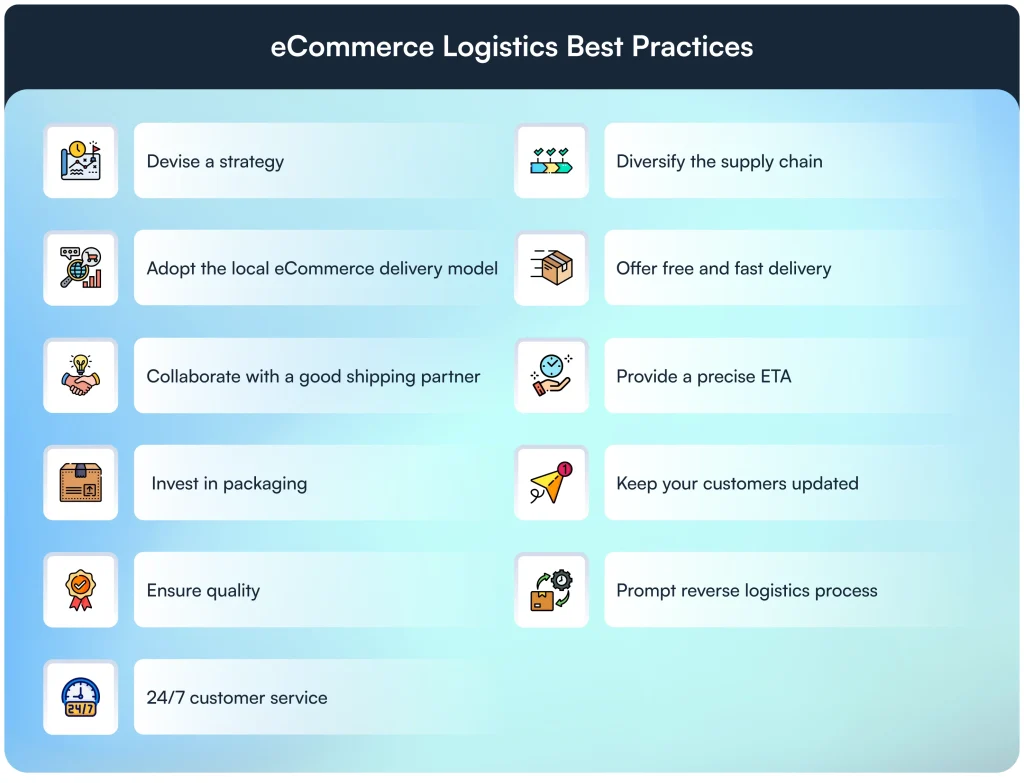Best Practices for Ecommerce Logistics and Shipping: Enhancing Efficiency and Customer Satisfaction

Exploring the world of ecommerce logistics and shipping, this introduction delves into the crucial role of efficient processes in the success of online businesses. From optimizing inventory management to choosing the right shipping strategies, this overview sets the stage for a comprehensive discussion on best practices.
Best Practices for Ecommerce Logistics and Shipping

Efficient logistics are crucial in the world of ecommerce as they directly impact customer satisfaction and operational costs. By implementing streamlined shipping processes, businesses can enhance the overall shopping experience for their customers, reduce shipping times, and optimize their supply chain operations.
Importance of Efficient Logistics in Ecommerce
Effective logistics in ecommerce play a key role in ensuring timely deliveries, managing inventory efficiently, and maintaining customer trust. When orders are processed and shipped promptly, customers are more likely to be satisfied with their shopping experience and are more likely to return for future purchases.
Examples of Streamlined Shipping Processes
- Utilizing real-time tracking systems to provide customers with visibility into the status of their orders.
- Implementing automated order fulfillment processes to reduce manual errors and speed up shipping times.
- Optimizing packaging practices to minimize shipping costs and reduce environmental impact.
Impact of Effective Logistics on Reducing Operational Costs
Efficient logistics can help ecommerce businesses reduce operational costs by minimizing shipping errors, reducing return rates, and optimizing inventory management. By streamlining their logistics processes, businesses can operate more efficiently, improve their bottom line, and stay competitive in the ecommerce market.
Inventory Management

Inventory management plays a crucial role in optimizing logistics for ecommerce businesses. It involves overseeing the flow of goods from suppliers to warehouses and ultimately to customers, ensuring that the right products are available at the right time to meet demand.
Maintaining Accurate Inventory Levels
Maintaining accurate inventory levels is essential for seamless shipping operations. Here are some strategies to achieve this:
- Implementing barcode or RFID technology for efficient tracking of inventory.
- Regularly conducting physical inventory counts to reconcile discrepancies.
- Utilizing inventory management software to automate tracking and alerts for low stock levels.
- Establishing clear processes for receiving, storing, and picking inventory to minimize errors.
Real-time Inventory Tracking Systems
Real-time inventory tracking systems offer numerous benefits in enhancing efficiency:
- Immediate visibility into stock levels for better decision-making and planning.
- Reduction of stockouts and overstock situations through accurate data.
- Integration with other systems like order management and shipping for seamless operations.
- Ability to forecast demand and optimize inventory levels based on real-time data.
Order Fulfillment Processes
Order fulfillment is a crucial aspect of ecommerce logistics that involves the steps from receiving an order to delivering the product to the customer. Efficient order fulfillment can lead to improved customer satisfaction and repeat business.
Steps Involved in Efficient Order Fulfillment
- Order Processing: The order is received, verified, and entered into the system.
- Inventory Management: Check the availability of products in stock.
- Picking and Packing: Products are picked from the inventory, packed securely, and labeled for shipment.
- Shipping: Choose the shipping method, print shipping labels, and send the package to the carrier.
- Delivery: Track the shipment and ensure timely delivery to the customer.
Comparison of Fulfillment Methods
- Dropshipping: Products are shipped directly from the manufacturer to the customer, reducing the need for inventory storage.
- In-House Fulfillment: The merchant manages the fulfillment process internally, maintaining control over quality and shipping speed.
- Third-Party Logistics: Outsourcing fulfillment to a third-party provider can save time and resources, especially for smaller businesses.
Benefits of Automating Order Fulfillment Processes
Automating order fulfillment processes can lead to increased efficiency and reduced errors in the following ways:
Automated order processing reduces manual data entry errors.
Integration with inventory management systems ensures accurate stock levels and prevents overselling.
Automatic tracking and notifications provide real-time updates to customers, improving transparency.
Shipping Strategies

When it comes to ecommerce logistics and shipping, having effective shipping strategies in place is crucial for the success of your business. Let's explore some key aspects to consider when planning your shipping methods.
Various Shipping Options
- Standard Shipping: This is the most common option, offering a balance between cost and speed.
- Expedited Shipping: Ideal for customers who need their orders quickly, though it may come at a higher cost.
- Same-Day Delivery: A premium service that caters to customers looking for instant gratification.
Choosing the Right Shipping Carriers
- Consider the size and weight of your products, as well as the destinations you ship to, when selecting a carrier.
- Compare shipping rates, delivery times, and reliability of different carriers to find the best fit for your business.
- Utilize a mix of carriers to offer customers various shipping options and improve flexibility.
Significance of Packaging Design
Packaging design plays a vital role in minimizing shipping costs and ensuring the safety of your products during transit. Here are some key points to keep in mind:
- Use lightweight materials to reduce shipping expenses without compromising product protection.
- Consider eco-friendly packaging options to appeal to environmentally conscious customers.
- Invest in sturdy packaging that can withstand the rigors of the shipping process, protecting your products from damage.
Conclusion
In conclusion, mastering the art of ecommerce logistics and shipping is essential for businesses looking to thrive in the digital marketplace. By implementing the discussed best practices, companies can streamline operations, reduce costs, and ultimately improve customer satisfaction.
FAQ Insights
How can efficient logistics impact customer satisfaction?
Efficient logistics ensure timely delivery, accurate tracking, and overall smooth shipping processes, leading to increased customer satisfaction.
What are the benefits of automating order fulfillment processes?
Automating order fulfillment reduces errors, speeds up processing times, and enhances overall operational efficiency.
How does packaging design affect shipping costs?
Thoughtful packaging design can minimize shipping costs by optimizing space, reducing weight, and ensuring product safety during transit.


